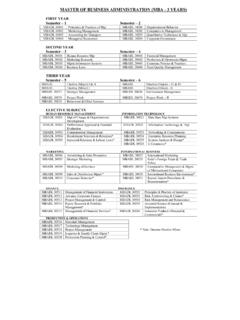Transcription of Impact of Technology on Logistics and Supply Chain …
1 IOSR Journal of Business and Management (IOSR-JBM) e-ISSN: 2278-487X, p-ISSN: 2319-7668 PP 19-24 7th international Business Research Conference 19 | Page Indian Education society 's Management College and Research Centre Impact of Technology on Logistics and Supply Chain Management Rajiv Bhandari F-303, Arenja Complex, Sector 8, Belapur Navi Mumbai 400614, 9819884293 Email Abstract:- The word Logistics has its origin from Greek word logistike which means the art of calculating. However, the modern interpretation of the term Logistics has its origin in the military, where it was used to describe the activities related to the procurement of ammunitions, and essential supplies for troops located at the front.
2 Logistics not only includes activities related to the physical movements of the goods but also manages relationship with suppliers and customers. However Logistic management is a means whereby the needs of customers are satisfied through integration and coordination of the Supply Chain . The main objective of the paper is to determine the various Technology used in Logistics and Supply Chain management including information Technology , communication Technology and automatic identification Technology . The paper also discusses the Impact of the Technology on Logistics and Supply Chain management. The author mainly focuses on the secondary data for collecting data relating to various Technology used in Logistics and Supply Chain management.
3 The author draws conclusion that Technology is a vehicle to enhance Supply Chain competitiveness and performance by enhancing the overall effectiveness and efficiency of Logistics system. Moreover various innovations in Technology have made the task easier and faster besides being less laborious. I. INTRODUCTION The council of logistic management defines Logistics as that part of Supply Chain process that plans, implements, and controls the efficient, effective, forward and reverse flow and storage of goods, services, and related information between the point of origin and the point of consumption in order to meet customer requirement . In ordinary language the same can be defined as right product, at the right place, in right time, and in right condition.
4 However Supply Chain consists of all stages that are required to satisfy the customer request. It starts from supplier passes through manufacturer, distribution, retailer and finally reaches the customer. The Supply Chain management is the oversight of materials, information and finances as they move in the process from supplier to manufacturer to wholesaler to retailer to customer. The emerging new technologies are creating strategic opportunities for the organizations to build competitive advantages in various functional areas of management including Logistics and Supply Chain management. However the degree of success depends on the selection of the right Technology for the application, availability of proper organizational infrastructure, culture and management policies.
5 In Logistics , information, communication and automation technologies has substantially increased speed of identification, data gathering, processing, analysis and transmission, with high level of accuracy and reliability. Technology is a means to enhance business competitiveness and performance. It plays a major role in success of Supply Chain by enhancing the overall effectiveness and efficiency of the Logistics system. In Logistics many new technologies are used in developed country while in India adoption process is very slow. However due to liberalization of the Indian economy the competitive pressure is building up and the only option to face the competition in to go in for Technology enabled operations. The latest technologies being used in Logistics and Supply Chain management are segregated into Automatic Identification Technology Communication Technology Information Technology II.
6 OBJECTIVES To determine the various Technology used in Logistics and Supply Chain management. To discusses the Impact of Technology on Logistics and Supply Chain management. IOSR Journal of Business and Management (IOSR-JBM) e-ISSN: 2278-487X, p-ISSN: 2319-7668 PP 19-24 7th international Business Research Conference 20 | Page Indian Education society 's Management College and Research Centre Automatic Identification Technology Automatic Identification (Auto ID) is the term used to describe the direct entry of data or information in the computer system, programmable logic controllers or any microprocessor-controlled device without operating a keyboard.
7 These technologies include Bar Coding, Radio Frequency Identification (RFID) and Voice Recognition. Auto ID can be used for tracking the containers, packages, cartons or a truck carrying the goods on time bound dispatches to the customers. The benefits of Auto ID include accuracy, cost saving, speed and convenience of data storage and processing of information. The significant Automatic Identification technologies in use are Bar coding Bar coding is a sequence of parallel lines of different thickness with spaces in between. These bars are nothing but the items of information in the codified form, which can be read with the help of a scanner. Historically bar codes was first used in a supermarkets in USA in information printed in bar code include, country code, manufacturer name, product details, date of manufacture, material content details are required at user end for inventory management.
8 The bar codes are used in diverse industries such as retail, pharmaceutical, consumer goods, electronics, automobiles etc. The bar coding offers the following advantages. Ease in identification of inventory items during storage, retrival, pickup, inspection and dispatch. Reduce paper work and processing time leading Reduce human error Increases Logistics system productivity through speed, accuracy and reliability. Impact of Bar code Technology on operations of Logistics and Supply Chain management Procurement operation The parts and components brought from suppliers are assigned bar codes, which contain information on item name, batch number, date of manufacture, order no, serial no etc. The information in bar code helps in identifying and tracking the component.
9 In the warehouse, when the goods enter through a conveyor, they are further scanned by the hand held scanner or scanner fixed alongside the conveyor. The information decoded by the scanner is immediately logged in the central computer which helps real time update of inventory records. Processing During the order processing the bar code will help in keeping identification of items based on their date of entry into the warehouse or store. This will ease material storage, retrival and dispatch in FIFO (First in First out) inventory management system. Production operation During the production process the identification of in-process and finished items become easier due to bar coding. The various bathes at different stages of production can be easily tracked.
10 Distribution operation During distribution, barcode helps in identifying and tracking the transit of finished goods to the customers. BARCODE Radio Frequency Identification (RFID) RFID is an Automatic Identification and Data Capture (AIDC) Technology . RFID first appeared in tracking and access applications during 1980. RFID-based systems allows for non contact reading and are effective in manufacturing and other hostile environment where bar codes could not survive. These are used as an alternative to Barcodes to communicate the inventory data to the reader via radio waves. RFID wirelessly exchanges information between a tagged object and a reader. IOSR Journal of Business and Management (IOSR-JBM) e-ISSN: 2278-487X, p-ISSN: 2319-7668 PP 19-24 7th international Business Research Conference 21 | Page Indian Education society 's Management College and Research Centre An RFID system is compromised of the following components as mentioned below.














